| Corcoran Technical Trading Patterns For November 4 |
| By Clive Corcoran |
Published
11/4/2008
|
Stocks
|
Unrated
|
|
|
|
Corcoran Technical Trading Patterns For November 4
In comparison to the wild intraday volatility seen over the last several weeks, trading in US equities in yesterday's session was extraordinarily subdued. Most charts reveal tiny range inside day patterns, and volume was very restrained. Clearly there is much caution ahead of what might well turn out to be a landslide victory for Obama.
As previously indicated, my longer term view is that there are is a lot of scope for downward surprises but I do expect that aggressive selling and renewed focus on further deleveraging by many kinds of financial intermediaries could see a respite in the leadup towards the end of the year.
The Nasdaq 100 index (^NDX) typifies the tiny range session seen yesterday and the retracement framework for this index from the June high to the lows seen in October shows a rather remarkable confluence between the 50-day EMA and the 38% retracement level just below 1500. It is to be expected that the bulls will be very wary once this index enters this price zone and a renewed pickup in volatility is very likely.
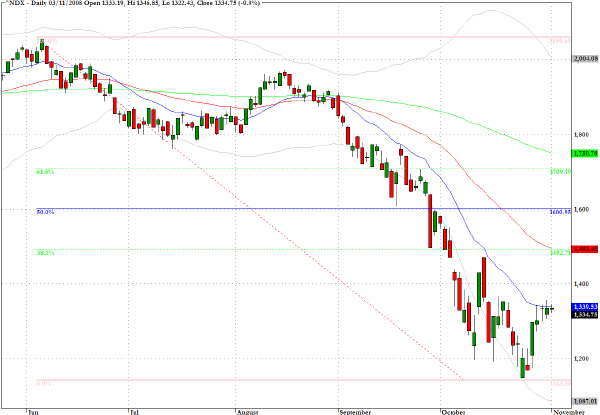
Reviewing the financials, as exemplified by the sector fund XLF, trading volumes have been very restrained since October 10 as there is continuing uncertainty about the pricing that the TARP program will apply to the more odious derivatives or troubled assets.
It would be of much concern to overall market sentiment, which is still fragile, if a pickup in volume, when it comes, is associated with further price erosion.
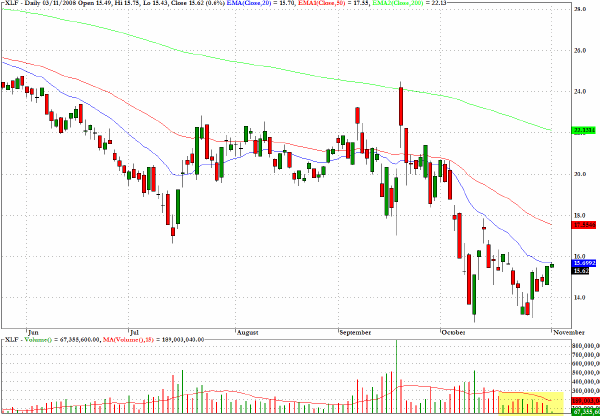
Sector funds that provide insights into the fixed income markets are very much at the top of my focus list at present. HYG is an ETF which tracks the high yield corporate bond market and as can be seen from the chart below there is scant evidence that asset allocators have a lot of confidence in the sector.
The principal reason for paying close attention to different sectors of the bond markets - both corporate and governments - is that there is a great deal of uncertainty as to the pricing of risky assets and the implementation of effective hedging strategies. This problem is further exacerbated by what could well become a hot topic when central bankers and politicians try to come to terms with the need to address the big picture, so called, financial architecture issues. In turn there are competing initiatives being advocated by those who still want to retain the basic components of a loosely defined Anglo Saxon model and those such as French prime minister Sarkozy and other Europeans who favor a more centrally managed approach. Intriguingly it is not entirely clear which way the new US administration will come down on some of these issues.
Perhaps relevant to this debate is something I wrote for another context but which could be part of the deeper worries that are preoccupying participants in the long-term fixed income world.
The Keynesian thrift paradox (or bubble deflation trap) that western economies are now confronting is crystallized in the awkward conundrum that expanding the money supply, reducing interest rates so that they are effectively negative and attempts to make credit more easily available are unlikely to be stimulative when consumers are, either more keen to pay off existing debts rather than expand their borrowings, or unable to borrow more since they have exhausted their ability to provide previously untapped collateral.
The Keynesian "solution" i.e. to inject large dollops of public sector monies to finance new infrastructure projects is now being contemplated as a cornerstone of new policy and is sure to be actively promoted at the forthcoming Bretton Woods II conference in mid-November.
It may not be too cynical to suggest that the focus on the need for new schemes that allow us to spend our way into a new era of prosperity, will have the effect of pushing the need to design a new financial architecture to avoid the excesses of the recent past, a lot lower on the agenda priorities than some believe it should have.
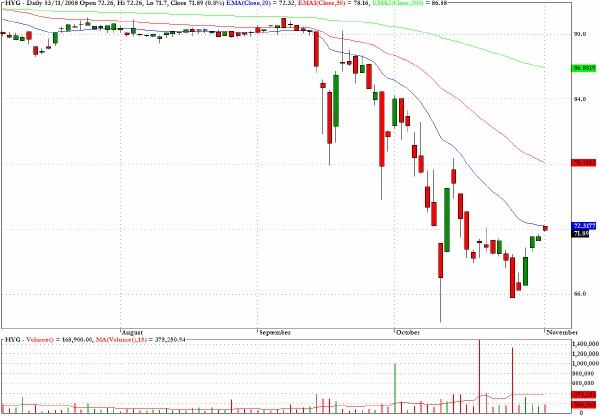
Emerging market debt was heavily sold during the sustained liquidations seen in October and this can be seen in the performance of the exchange traded fund PCY.
At present there is a sharp "V" shaped recovery which could have some distance to go, possibly to the $20 level, but there is plenty of scope for sudden setbacks.
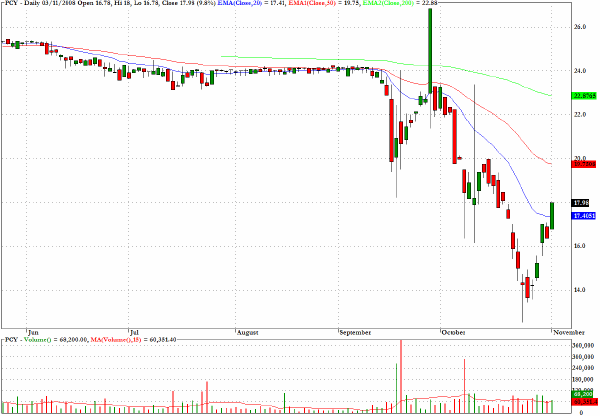
Among several pattern recognition scans that I perform daily, the chart pattern for BBH, an ETF for the biotech sector, has been flagged as a short based upon the pullback to a potential chart resistance level.
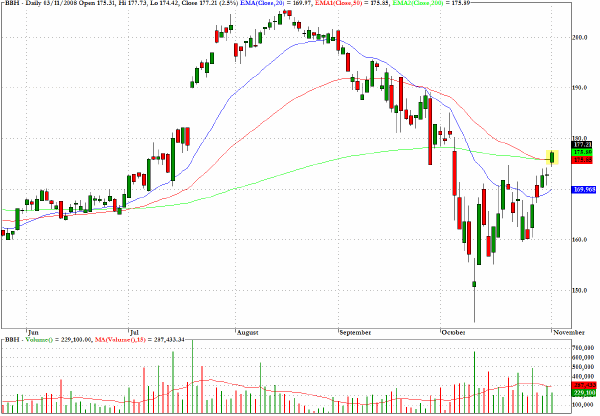
Clive Corcoran is the publisher of TradeWithForm.com, which provides daily analysis and commentary on the US stock market. He specializes in market neutral investing and and is currently working on a book about the benefits of trading with long/short strategies, which is scheduled for publication later this year.
Disclaimer
The purpose of this article is to offer you the chance to review the trading methodology, risk reduction strategies and portfolio construction techniques described at tradewithform.com. There is no guarantee that the trading strategies advocated will be profitable. Moreover, there is a risk that following these strategies will lead to loss of capital. Past results are no guarantee of future results. Trading stocks and CFD's can yield large rewards, but also has large potential risks. Trading with leverage can be especially risky. You should be fully aware of the risks of trading in the capital markets. You are strongly advised not to trade with capital.
|